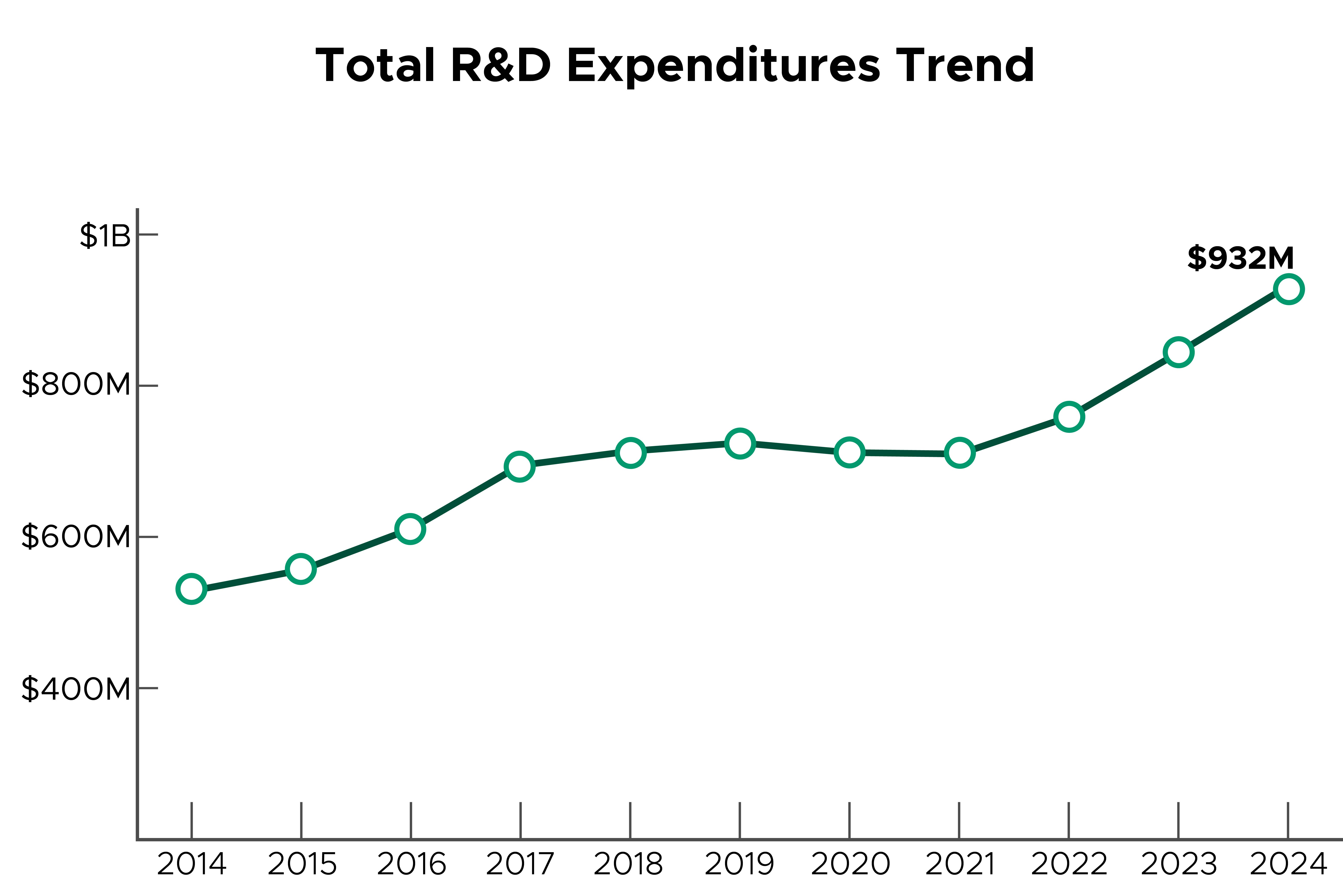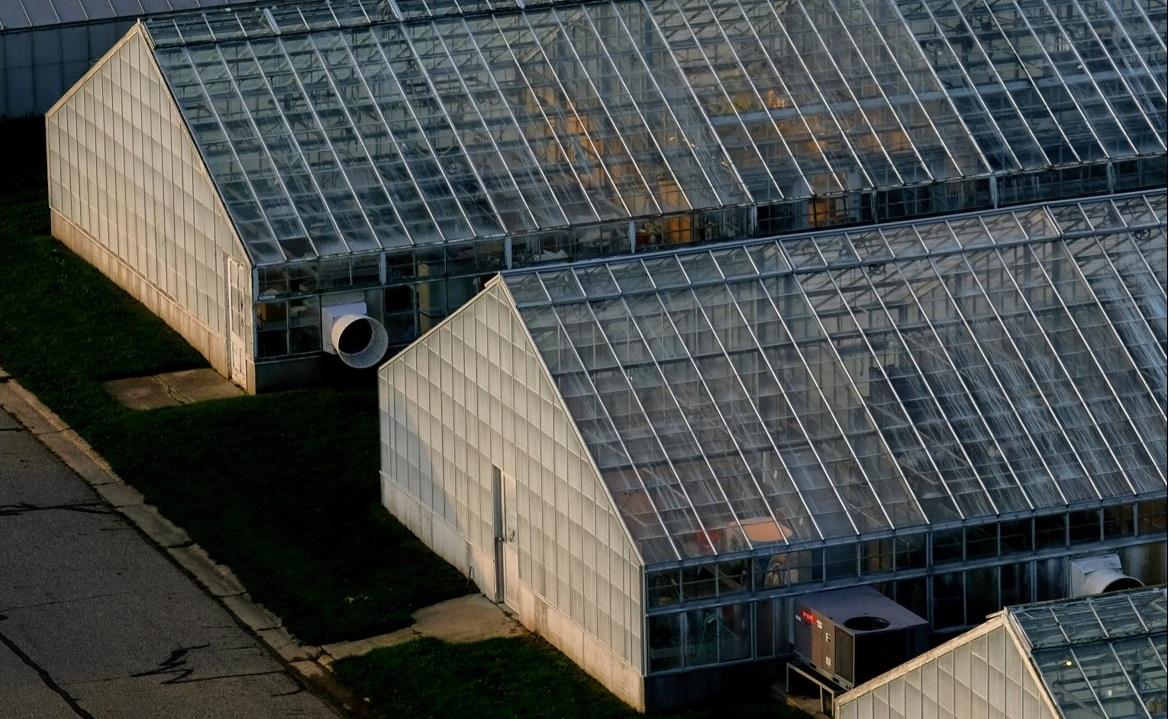Research Expenditures
Research expenditures – that is, the funds spent to conduct research – are the most frequently cited numbers for comparing research levels among colleges and universities. The National Science Foundation (NSF) surveys all recipients of federal funds annually, asking about their research expenditures from all funding sources. MSU has participated in that survey since 1998. The NSF numbers constitute the most comprehensive listing of research expenditures and provide consistency for comparison with other institutions.
MSU's total research expenditures were $932 million for FY2024, an increase of $87.8 million over the 2023 total of $844 million. Research expenditures from federal sources totaled $474 million, an increase of $39 million or 9%.
Top federal funding agencies: Department of Energy, Department of Health and Human Services, National Science Foundation, Department of Agriculture (USDA), U.S. Agency for International Development, and the Department of Defense.
Major contributors to MSU's #1 national ranking in DOE expenditures include the MSU and U.S. Department of Energy-funded Facility for Rare Isotope Beams (FRIB) as well as the MSU-DOE Plant Research Laboratory, the Great Lakes Bioenergy Research Center and several other interdisciplinary and multi-institutional research projects.
Source: NSF HERD 2023 Data


Research Funding
Funding for externally sponsored programs comes primarily from federal agencies, state agencies, industry, associations, and foundations. Competitive internal grants programs and Facilities and Administrative (F&A) cost return also support research. Funds for conducting research are generally awarded in multi-year contracts or grants, therefore the amount recorded as received each year may not reflect the research being done in that year.
For additional facts and figures about the MSU research enterprise, or statistics about the university, please review the Data Digest or Planning Profile Summary, (MSU authentication required) produced by the Office of Institutional Research.
Innovation and Tech Transfer
The MSU Innovation Center stewards scientific and creative discoveries into a pipeline of patents, products and startup businesses. In FY 2024, the MSU Innovation Center recorded 178 invention disclosures, and 72 new patent applications along with 47 US issued patents. Productivity resulted in $25.3M dollars in corporate support for research projects. Additionally, $4.6M in income from licenses was generated through royalties distributed back to MSU faculty and departments.
Top Faculty
The university attracts and welcomes an international community of outstanding graduate students, postdoctoral associates, and faculty visitors to a broad range of highly ranked graduate programs, research centers, and interdisciplinary collaborations. As of Fall 2024, approximately 1,890 tenure-stream faculty, 1,229 fixed-term faculty and 2,549 academic staff (including 600 post-doctoral research associates), and 7,334 degree-seeking graduate students (master's and doctoral) were among the MSU community of scholars.
- MSU boasts 11 members of the National Academy of Sciences.
- MSU has eight members in the American Academy of Arts and Sciences.
- Other notables include Guggenheim, Packard, and Sloan Fellows, Pulitzer Prize and Grammy Award winners, and one recipient of the World Water Prize.
- Learn more on the Faculty Recognition page and also see the Honored Faculty website.
University Rankings
Michigan State University is a top global research university. The MSU Office of Financial Planning and Budget tracks several ranking outlets comparing undergraduate and graduate programs, and global university research rankings. Global rankings include US News, Times Higher Education, Shanghai, and Quacquarelli Symonds. Visit the Rankings page to view:
- Undergraduate Rankings
- Graduate Rankings
- Global Rankings

Greenhouse facilities on campus will be upgraded and expanded over the next year thanks, in part, to investment from the State of Michigan.
Current Infrastructure and Facilities Projects
Greenhouse Renovation and Additions
This project is anticipated to upgrade the Plant Sciences Greenhouse Range through a combination of renovations and additions that include state-of-the-art environmental controls and LED lighting configured to respond to varying external climate conditions. The upgraded greenhouses will have the ability to conduct controlled, replicated experiments regardless of the season and under a variety of growth, environmental and stress conditions. The project is underway with expected completion September 2025. Visit the Infrastructure Planning and Facilities project page for details.
Dairy Facility Renovations and Additions
This project is anticipated to primarily consist of construction of new dairy facilities along with renovations at the existing location on south campus, leveraging some of the existing infrastructure, in particular the methane digester, expanded feed production capacity and nutrient management operations, and may be undertaken in phases. Construction began May of 2024 and is expected to be completed September 2025. Visit the Infrastructure Planning and Facilities project page to learn more.
Henry Ford Health + MSU Health Sciences Research Facility
The proposed building will provide physical space to support the joint Health Sciences research initiative of MSU and Henry Ford Health (HFH) in Detroit as part of the broader Future of Health: Detroit project. Research areas of focus will include (but aren't limited to) cancer, neuroscience, immunology and infectious diseases, with a particular interest in health inequities and disparities and social determinants of health. The HFH+MSU Research Building is expected to be eight stories and approximately 335,000 GSF. The university's strategic partnership with HFH is a key component to expanding research, along with expanding MSU’s footprint in Detroit, and creating the cornerstone for a National Cancer Institute designated cancer center.
This project is anticipated to include wet bench laboratories and central support facilities including core labs, vivarium, and common meeting areas. MSU and HFH will collaborate on the planning and design. The project is located on the HFH campus in Detroit. Learn more on the Infrastructure Planning and Facilities project page or read the press release from the groundbreaking held June 17, 2024.
Engineering and Digital Innovation Center (in planning)
The building is envisioned to comprise two components. One would be dedicated to digital learning with active classrooms, teaching laboratories, student project studios, and e-sports. The other part would be dedicated to laboratories supporting experimental and computational research, core facilities, clean rooms, and flexible modular research units; and vibrant community spaces to support informal gathering and collaboration.
The new building will support an increase in enrollment of new undergraduate students in computational sciences and digital literacy disciplines and in graduate related programs; prepare MSU graduates with skills in computational sciences and digital literacy necessary for postgraduate success; and become MSU’s center for excellence in advanced manufacturing, materials science, ultrafast science, and quantum computing including heterogeneous micro-electronic technologies. Learn more on the Infrastructure Planning and Facilities project page.
Plant and Environmental Sciences Building
The new building would provide new capacity, align modern building infrastructure and space functionality and support the consolidation of top ranked researchers and students, thereby enabling new synergies and enhancing potential for discovery. The programmatic vision focuses on research at the interface of plants and the environment with a focus on agriculture and ecological resilience; fundamental mechanisms of plant growth, photosynthesis, and evolution and resistance to stress/change. The groundbreaking for this building took place on October 25, 2024. Read more about the building on MSU Today.
Recent Infrastructure and Facilities Advancements
The Facility for Rare Isotope Beams (FRIB)—a $730M scientific user facility funded by the U.S. Department of Energy Office of Science, MSU, and the state of Michigan—will advance nuclear physics and provide research opportunities for scientists and students from around the globe. FRIB opened in spring 2022, ahead of schedule and on budget.
IceCube is the world’s largest neutrino detector, using a billion tons of the Antarctic ice cap beneath the U.S. Amundsen-Scott South Pole Station to observe neutrinos. It is operated by a collaboration of 300 physicists from 48 universities and national laboratories in 12 countries. MSU is a major participant in this NSF research facility and will help lead an NSF-funded $300M expansion.

The Interdisciplinary Science and Technology Building opened in August 2019.
New in 2016, the Institute for Quantitative Health Science and Engineering (IQ) aims to foster collaboration among the sciences on campus and beyond, creating endless possibilities for transforming patient care with new biomedical discoveries. IQ has grown to more than 36 faculty in 16 departments (six colleges) with additional affiliated faculty across campus. MSU recruited IQ director Chris Contag from Stanford and Precision Medicine chair Anna Moore from Harvard.
The new Interdisciplinary Science and Technology Building opened in August 2019, is a neighbor to IQ, and together with Life Sciences, Radiology, and the Clinical Center, forms a dedicated biomedical research complex on south campus. It currently houses the Precision Health Program among other interdisciplinary groups.
McLaren Health Care's new hospital facility on the campus of MSU opened in early 2022. The comprehensive health care campus is home to more than 1,000 physicians, researchers, educators and other members of the academic and medical team, and provides collaborative research opportunities and clinical training for medical students.
The Billman Music Pavilion in the College of Music opened in 2021. The new facility and renovated space in the Music and Music Practice buildings provides advanced acoustical engineering and custom designed spaces within a climate-controlled environment for creative activity.
The Minskoff Business Pavilion, opened in fall 2019, enhances the Broad student experience through its design around community, collaboration and teamwork. The space provides resources for research, innovation and the development of transformational business leaders.
The MSU Libraries and the College of Arts & Letters partnered to build a state-of-the-art Digital Scholarship Lab, opened in February, 2018. The 10,000-square-foot space features a 360-degree immersive visualization room, graphics-intensive computing software and interactive visualization for research projects and scholarly exploration.
Grand Rapids Research Center was completed in 2017 with space for 44 research teams in translational science and molecular medicine, pediatrics, and OBGYN. An additional building next door recently broke ground for expanded research collaborations with Spectrum Health, the Van Andel Institute and others.
The Plant Resilience Institute was formed in 2016 under the Global Impact Initiative. Its mission is to enhance plant resilience to environmental challenges including extremes in weather and climate change, and to become a “Center of Excellence” for foundational and translational plant research aimed at increasing the productivity and quality of food and energy crops.
Launched in 2015, the department of Computational Mathematics, Science, and Engineering or CMSE was planned, authorized, and operational in only three years. CMSE is unique among computational academic units nationally - it is focused on data science, machine learning, advanced computation and related applications, but is not a traditional CS department. It supports many of the new efforts on campus that require the analysis of large data sets and development of new tools and algorithms.
